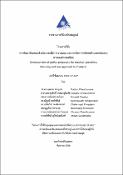บทคัดย่อ
การวางแผนกำลังคนแพทย์เฉพาะทางมีความสำคัญต่อการจัดการระบบบริการสุขภาพเป็นอย่างมาก และมีความสำคัญในทุก ๆ ระดับการบริการ การวิจัยดำเนินการเพื่อพัฒนาหลักฐานและแนวทางทางวิชาการในการวางแผนกำลังคนแพทย์เฉพาะทาง ประกอบไปด้วย 4 วัตถุประสงค์ ได้แก่ วิเคราะห์ความต้องการกำลังคนแพทย์เฉพาะทางของประเทศไทยในปัจจุบัน เพื่อคาดการณ์ความต้องการกำลังคนแพทย์เฉพาะทาง ในปี พ.ศ. 2570 2575 และ 2580 ในสถานการณ์ต่าง ๆ เพื่อพยากรณ์จำนวนกำลังคนแพทย์เฉพาะทางรองรับในปี พ.ศ. 2570 2575 และ 2580 และเพื่อจัดทำข้อเสนอเชิงนโยบายการวางแผนกำลังคนแพทย์เฉพาะทางของประเทศไทย โดยมีขอบเขตของการศึกษาที่ประกอบไปด้วย การวิเคราะห์ความต้องการกำลังคนแพทย์เฉพาะทางและกำลังคนรองรับประกอบไปด้วย 16 สาขาหลักในประเทศไทย และ 8 อนุสาขาของศัลยศาสตร์ และอายุรศาสตร์ การวิจัยดำเนินการด้วยวิธีการที่หลากหลายเพื่อให้ได้คำตอบตามวัตถุประสงค์ของการวิจัย ทั้งการวิจัยเชิงปริมาณ และการวิจัยเชิงคุณภาพ โดยกรอบแนวคิดหลักของการศึกษา คือ การวิเคราะห์ความต้องการแพทย์เฉพาะทางตามวิธีการด้านอุปสงค์ โดยพัฒนาเครื่องมือช่วยในการวิเคราะห์ตามแนวทางขององค์การอนามัยโลก Workload Indicators of Staffing need (WISN) ร่วมกับวิธี Benchmarking และ population ratio การพยากรณ์ความต้องการในอนาคตใช้ปัจจัยทางด้านโครงสร้างอายุและเพศของประชากรเป็นปัจจัยหลักในการพยากรณ์ทางด้านกำลังคนรองรับหรืออุปทาน เป็นการวิเคราะห์ตามแนวคิด stock-and-flow โดยใช้ข้อมูลจำนวนในปัจจุบัน วิเคราะห์ร่วมกับอัตราการเกษียณ อัตราการตาย อัตราการคงอยู่ และอัตราการเรียนจบใหม่ที่พยากรณ์ด้วย Exponential Smoothing technique การศึกษาครั้งนี้ใช้ one-way sensitivity analysis ในการวิเคราะห์ความผันผวนของผลการศึกษาจากตัวแปรที่มีความไม่แน่นอนทั้งในส่วนของอุปสงค์และอุปทานของแพทย์เฉพาะทาง การรวบรวมข้อมูลภาระงานเป็นการรวบรวมด้วยแบบสอบถาม และการสัมภาษณ์ การวิเคราะห์ฉากทัศน์และรวบรวมข้อคิดเห็นทางนโยบายเป็นการวิจัยเชิงคุณภาพ ข้อมูลในการจำแนกการบริการสุขภาพตามประเภทแพทย์เฉพาะทางเป็นข้อมูลทุติยภูมิโดยไม่ระบุตัวตนจากแหล่งข้อมูลระดับประเทศ ผลการศึกษาในภาพรวมบ่งชี้ถึงความต้องการการรับบริการสุขภาพที่มากขึ้น ความต้องการแพทย์เฉพาะทางที่มากขึ้น และกำลังคนรองรับหรืออุปทานแพทย์เฉพาะทางที่มากขึ้นเช่นกัน โดยเมื่อเทียบกับความต้องการและอุปทานแพทย์ทั้งหมดพบว่าประเทศไทยมีการผลิตแพทย์ที่เพียงพอต่อการผลิตแพทย์เฉพาะทางในภาพรวมในอนาคต ผลการศึกษาบ่งชี้ความไม่เพียงพอของแพทย์เฉพาะทางทุกสาขาในปัจจุบัน โดยเฉพาะเมื่อเทียบกับแพทย์เฉพาะทางของประเทศพัฒนาแล้ว อย่างไรก็ตามหากพิจารณาเปรียบเทียบอุปสงค์และอุปทานแพทย์เฉพาะกรณีของประเทศไทย สาขาอายุรแพทย์ แพทย์เวชศาสตร์ครอบครัว แพทย์เวชศาสตร์ฉุกเฉิน แพทย์ทางด้านศัลยแพทย์ และจิตแพทย์ มีแนวโน้มจะมีความไม่เพียงพอมากกว่าสาขาอื่น ๆ ในบางสาขา ความต้องการแพทย์เฉพาะทางบางสาขามีแนวโน้มลดลงจากการเปลี่ยนแปลงของโครงสร้างประชากรไทย การวิเคราะห์ฉากทัศน์พบความสำคัญของปัจจัยโรคไม่ติดต่อเรื้อรัง ปัจจัยความเสี่ยงจากยาเสพติด อีกทั้งพบว่าปัจจัยด้านนโยบายมีความสำคัญมากต่อการวางแผน และจัดการกำลังคนแพทย์เฉพาะทางทั้งในปัจจุบันและอนาคต การทบทวนการวางแผนกำลังคนอย่างสม่ำเสมอมีความเป็นไปได้ และควรดำเนินการเพื่อให้เกิดการปรับตัวที่ทันต่อความต้องการรับบริการสุขภาพ การทบทวนนโยบายที่ส่งผลต่อการจัดบริการสุขภาพระดับปฐมภูมิ ทุติยภูมิ และตติยภูมิ มีความจำเป็นที่ต้องดำเนินการร่วมกัน เพื่อให้ทิศทางเป็นไปในลักษณะเดียวกัน ส่งผลโดยตรงต่อการวางแผนกำลังคนแพทย์เฉพาะทางต่อไป
บทคัดย่อ
The strategic planning of a specialized workforce is crucial for the effective management of
the healthcare system and is significant at all service levels. The study aimed to establish evidence
and academic guidelines for specialist workforce planning, comprising four objectives: to assess the
current demand for specialists in Thailand, to project the demand for specialists in 2027, 2032, and
2037 under various scenarios, to estimate the supply of specialists in 2027, 2032, and 2037, and to
formulate policy recommendations for specialist workforce planning in Thailand. The report
encompasses an investigation of the demand for expert labor and support workforce across 16 primary
branches in Thailand, together with 8 sub-branches in surgery and internal medicine.
The research employed many methodologies to address the research aims, incorporating both
quantitative and qualitative approaches. The study's conceptual framework involves analyzing
specialist demand through a demand-side approach. The research utilized the World Health
Organization's standards on Workload Indicators of Staffing Need (WISN). It additionally employed the
Benchmarking and population ratio methodologies. The primary determinant utilized for projecting
future demand was the demographic composition by age and gender. The analysis of personnel
support or supply employs the stock-and-flow approach, utilizing current data alongside retirement,
retention, and new graduate rates, which are projected using the Exponential Smoothing technique.
The one-way sensitivity analysis for uncertain parameters was adopted for both demand and supply
sides to indicate the possible results. The acquisition of workload data was conducted using
questionnaires and interviews. The examination of situations and the aggregation of policy perspectives
constituted qualitative research. The classification of health services by specialist type utilized
anonymous secondary data from national sources.
The study results reveal a heightened demand for health services, an increasing need for
specialists, and an augmented supply of specialist staff. Thailand has generated a sufficient number of
doctors to ensure the future availability of specialists, relative to the total demand and supply of
medical professionals. The overall findings reveal a present deficiency of specialists across all
disciplines, particularly in comparison to those in developed nations. Nevertheless, a comparison of
the demand and supply of specialist physicians in Thailand, medical internists, family medicine,
emergency medicine, surgery, and psychiatry are comparatively more deficient than other specialties.
The demand for some professionals is declining due to alterations in the demographic composition of
the Thai population. The scenario analysis identified the significance of non-communicable chronic
disease variables, drug risk factors, and policy factors as crucial for the planning and management of
the specialized workforce, both currentlyand in the future. Consistent evaluation of workforce planning
is feasible and should be conducted to timely adapt to the demand for health services. The review of
policies affecting the provision of primary, secondary, and tertiary health services s is essential to assure
alignment, which will directly influence future specialist workforce planning.


